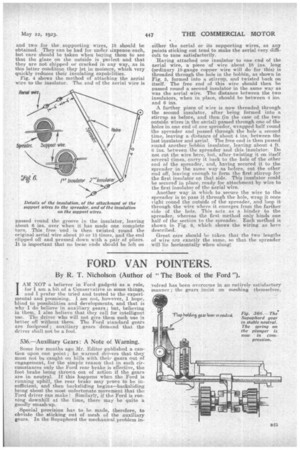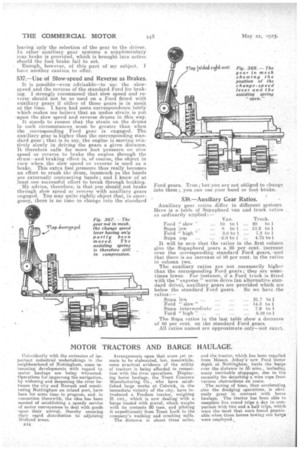FORD VAN POINTERS.
Page 29

Page 30

If you've noticed an error in this article please click here to report it so we can fix it.
By R. T. Nicholson (Author of "The Book of the Ford ").
/AM NOT a believer in Ford gadgetS as a rule, for I am, a bit of a Conservative in some things, and I prefer the tried and tested to the experimental and promising. I am not, however, I hope, blind to possibilities and developments, and that is why I do believe in auxiliary gears ; but, believing in them, I also believe that they call for intelligent. use. The driver who will not give them such use is better off without them: The Turd standard gears are foolproof ; auxiliary gears demand that the driver shall not be a fool.
536.—Auxiliary Gears : A Note of Warning.
Some few months ago Mr. Editor published a caution upon one point; he warned drivers that they must not he caught on hills with, their gears out of engageinent, for the simple reason that in such circumstances only the Ford rear brake is effective, the foot brake being thrown out of action if the gears are in neutral. If this happens when the Ford is running uphill, the rear brake may prove to be insufficient, and then backsliding begins—backsliding being about the most unfortunate movement that the• Ford driver can make ! Similarly, if the Ford is run. ning downhill at the time, there may be quite, a goodly smash-up.
Special Provision has to be made, therefore, to obviate the sticking out of mesh of the auxiliary gears. In the Supaphord the mechanical problem in
volved has been overcome in an entirely satisfactory manner ; the gears insist on meshing themselves, leaving only the selection of the gear to the driver. In other auxiliary gear systems a supplementary rear brake is provided, which is brought into action should the foot brake fail to act.
Enough, however, of this part of my subject. have another caution to offer.
537.—Use of Slow-speed and Reverse as Brakes.
It is possible—even advisable—to use the slowspeed and the reverse of the standard Ford for braking. 1 strongly recommendthat slow speed and reverse should not be so used on a Ford fitted with auxiliary gears if either of those gears is in mesh at the time. I have had mane correspondence lately which makes me believe that an undue strain is put 'upon the slow speed and reverse drums in this way.
it stands to reason that the strain on. the drums in such circumstances must be greater than when the corresponding Ford gear is engaged. The auxiliary gear is higher than the corresponding standard gear ; that is to say, the engine is moving relatively slowly in driving the gears a given distance. It therefore calls for more foot pressure on slow speed or reverse to brake the engine through the drum—and braking effect is, of course, the object in view when the slow speed or reverse is used as a brake. This extra foot pressure thus really becomes an effort to crush the drum, inasmuch as the bands are externally contracting bands ; and I know of at least one successful effort to break through braking. Mk advice, therefore, is that you should not brake through slow speed or reverse with auxiliary gears engaged. You may quite rightly object that, in erner-. geney, there is no time to change into the standard
538.—Auxiliary Gear .Ratios.
Auxiliary gear ratios._ differ in different systems. Here is atable of .Supaphord van and truck ratios as ordinarily applied:— Van. Truck.
Ford " slow ' ... 10. to I ... 20 to 1
Supa low „. ... S to 1 ... 13.2 to 1 Ford " high " ... 3.6 to 1 ... 7-.2 to 1
Supa top ... ... –2.9 to 1 ... 4.75 to 1
It will be seen that the ratios in the first column give the Supaphord gears a 25 per cent. increase over the corresponding standard Ford gears, 'and that there is an increase of 50 per cent. in the ratios in column two.
The auxiliary ratios are not necessarily higher than the corresponding Ford gears; they are sometimes lower. For instance, if a Ford truck is fitted with the " express " worm drive (an alternative standard drive), auxiliary gears are provided which are below the standard Ford gears. So we have the ratios:— .
Supa law ... 21.7 to 1 Ford " slow" 14.3 to 1
Supa intermediate ... 7.9 to 1 Ford "high ". ... ---•5.16 to 1 The Supa ratios in the last table show a decrease of 50 per cent. on the standard Ford gears.
All ratios named are approximate only—not exact.


































